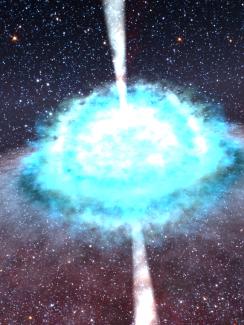Black holes have a new item on their dinner menu: a three-dimensional glowing sphere of stellar debris that looks like a star. The sphere provides a sumptuous main course for a supermassive black hole, while emitting excess energy via jets erupting from its polar regions. The idea for this new type of gourmet feast for black holes comes compliments of graduate student Eric Coughlin and Fellow Mitch Begelman.
Of course, astrophysicists have known for a long time that supermassive black holes feed on stellar debris. Stars in orbit around these black holes are subject to powerful tidal forces that can steal their outer layers or even blow them apart. Until now, however, scientists thought this debris simply formed a disk around the black hole.
However, something else can happen with smaller monster black holes with a mass of ~ 1 million suns, according to Coughlin and Begelman. Material can flow into the black hole so rapidly that the black hole emits enough radiation to puff up the disk of stellar debris into a sphere.
But, soon the new sphere of hot gas has a problem: what to do about all the energy the black hole is liberating as it feasts on the stellar debris that surrounds it. This is an easy problem to solve when dinner is a disk: energy can rapidly dissipate in all sorts of directions.
However, there’s no easy way out for all this energy in a glowing sphere of stardust. At first, the hot gas just absorbs the energy. But, eventually it has to spit out all this energy either by (1) blowing itself to bits, or, more often, (2) forming the jets that erupt from its poles sometime after the debris puffs up.
But, why do some disks puff up in the first place? Coughlin and Begelman think they have figured out the answer to that question, too. Even though a star had a lot of angular momentum as it spins in orbit around a black hole, it doesn’t always have enough angular momentum to maintain a debris disk around a black hole after the star is destroyed. When this happens, the debris puffs up and looks like a star.
Coughlin and Begelman are now investigating whether their new understanding of the behavior of tidal debris around black holes will shed light on what happens to generate short and long gamma ray bursts during the collapse of stars into neutron stars or stellar-sized black holes.—Julie Phillips



 The Physics Frontiers Centers (PFC) program supports university-based centers and institutes where the collective efforts of a larger group of individuals can enable transformational advances in the most promising research areas. The program is designed to foster major breakthroughs at the intellectual frontiers of physics by providing needed resources such as combinations of talents, skills, disciplines, and/or specialized infrastructure, not usually available to individual investigators or small groups, in an environment in which the collective efforts of the larger group can be shown to be seminal to promoting significant progress in the science and the education of students. PFCs also include creative, substantive activities aimed at enhancing education, broadening participation of traditionally underrepresented groups, and outreach to the scientific community and general public.
The Physics Frontiers Centers (PFC) program supports university-based centers and institutes where the collective efforts of a larger group of individuals can enable transformational advances in the most promising research areas. The program is designed to foster major breakthroughs at the intellectual frontiers of physics by providing needed resources such as combinations of talents, skills, disciplines, and/or specialized infrastructure, not usually available to individual investigators or small groups, in an environment in which the collective efforts of the larger group can be shown to be seminal to promoting significant progress in the science and the education of students. PFCs also include creative, substantive activities aimed at enhancing education, broadening participation of traditionally underrepresented groups, and outreach to the scientific community and general public.